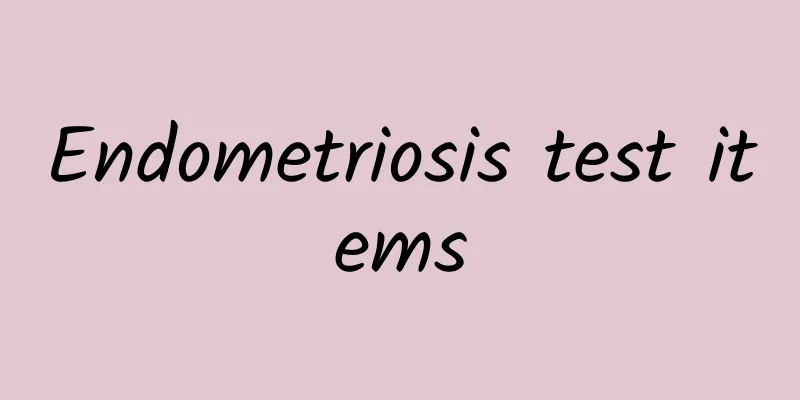Endometriosis test items

|
Normally, if a woman suffers from endometriosis, she will have some special symptoms, including heavy menstrual flow and dysmenorrhea. Doctors can usually use these symptoms to preliminarily determine that a woman may have endometriosis, but they cannot make a final diagnosis based on this alone. Further examination is needed at this time. So, what are the methods for examining endometriosis? Endometriosis Test Only on the basis of accurate examination and diagnosis of the disease can the doctor give the best treatment plan and the patient has the possibility of recovering health. Endometriosis is one of the common gynecological diseases in women and needs timely examination and treatment. The following experts will introduce the examination methods of endometriosis. What tests are needed to diagnose endometriosis? Inspection item 1: X-ray examination (1) Hysterosalpingography: Due to ectopic lesions on the posterior wall of the uterus, uterosacral ligaments, rectum and appendages, the uterus is retroverted and fixed to form a mushroom or parasol shape. The ovaries are cystic and enlarged, with iodized oil residue around the umbrella tip. The fallopian tubes are often unobstructed or unobstructed. Due to adhesions in the pelvic cavity, 24-hour X-ray review shows that the iodized oil in the pelvic cavity is in the form of small lumps of varying thickness and dot-like snowflake distribution. (2) Pneumoperitoneotomy: In endometriosis, pelvic masses are often bilateral, and the uterus and appendages often adhere to each other, forming irregular whitening shadows of varying densities. The frontal view shows that the distance between the uterus and the rectum becomes smaller and whiter. The lateral view shows that the uterine rectal pouch becomes shallower and whiter. Double contrast is the best way to examine pelvic endometriosis, because it can show the condition of the cervix and fallopian tubes, and can also reflect the condition of pelvic adhesions and ovarian masses. Examination Item 2: B-ultrasound examination At present, B-ultrasound imaging is an effective method for assisting the diagnosis of endometriosis. It is mainly used to observe ovarian endometriosis cysts. The characteristics of its sonogram are as follows: ① The most common image is a cystic mass with unclear boundaries, sparse light spots inside, thick cystic fluid, and sometimes dense, coarse light spots due to the concentration and organization of old blood clots. It is a mixed mass. ② The mass is often located on the posterior side of the uterus, and cystic uterine complications can be seen, that is, the cyst image and the uterine image overlap to varying degrees. ③ The cyst sometimes ruptures spontaneously, and the sonogram shows that there is fluid accumulation in the posterior depression, and the cyst is smaller than the front. Examination Item 3: Laparoscopy Laparoscopy is currently the main method for diagnosing endometriosis. Laparoscopy can directly peer into the pelvic cavity, and the diagnosis can be confirmed by seeing the ectopic lesions. The staging can be carried out according to the findings, which is convenient for deciding the treatment plan. There are many manifestations of ectopic lesions under laparoscopy: ① The color of the lesions can be red, cyan, black, brown, white, gray, etc. ② The shape of the lesions can be dot-like, nodular, vesicular, polyp-like, etc. Sometimes peritoneal defects or small pouches are seen, with ectopic lesions at the bottom. ⑧ Pathological findings: endometrial glands and stroma. Examination Item 4: Immunological Testing In recent years, many studies have shown that the onset of endometriosis is related to immunity. In women with cellular immune deficiency, endometrial fragments can be implanted in the peritoneum, leading to endometriosis. Currently, there are several immune indicators that can be used as a reference for diagnosing endometriosis: ① macrophages; ② interleukin I and II; ⑧ autoantibodies; ④ cellular immunity, humoral immunity and complement. Now, I believe everyone has understood the methods for checking endometriosis in women. If a woman has abnormal menstruation, it is recommended to go to a regular hospital for examination as soon as possible. If the diagnosis is endometriosis, symptomatic treatment should be given in time, otherwise it will affect the woman's normal pregnancy. |
<<: Early detection and early treatment of endometriosis
>>: What to do if women have itching in their lower body
Recommend
What should not be eaten for pelvic effusion? What are the methods for treating pelvic effusion?
What can't you eat if you have pelvic effusio...
What are the main causes of adnexitis?
Adnexitis is a very common disease. As a patient,...
The more you eat, the thinner you get! Fall and winter love seasoning weight loss method
Eat a little every day and lose a little weight! ...
Brief analysis of the two most common symptoms of uterine fibroids
Among the various symptoms of uterine fibroids, t...
Experts explain what to pay attention to after painless abortion
Many female friends may be familiar with painless...
Will green dregs of vaginal discharge heal itself? Is it vaginal candidal infection?
Green dregs of vaginal discharge will not heal on...
Are the symptoms of uterine fibroids obvious?
In today's society, there are more and more d...
The Mediterranean diet is once again crowned the best diet! The Mediterranean diet not only protects your cardiovascular system, but also your bones
The main characteristics of the Mediterranean die...
The three most obvious symptoms of cervicitis
The three most obvious symptoms of cervicitis are...
How to prevent pelvic peritonitis
We all know that women's reproductive organs ...
How long should I rest after miscarriage? How should I care after miscarriage?
How long should you rest after an abortion? This ...
What are the prevention methods for cervical hypertrophy?
For women, cervical hypertrophy is a common disea...
Will fertility be affected after treatment of chronic cervicitis? How to prevent chronic cervicitis in women?
Chronic cervicitis is a gynecological inflammatio...
How is Bartholinitis diagnosed?
The Bartholin's glands are located at the bac...
Climb Dakeng Trail No. 9 to easily get rid of the calories in chicken chop
Many people who visit night markets or have midni...









